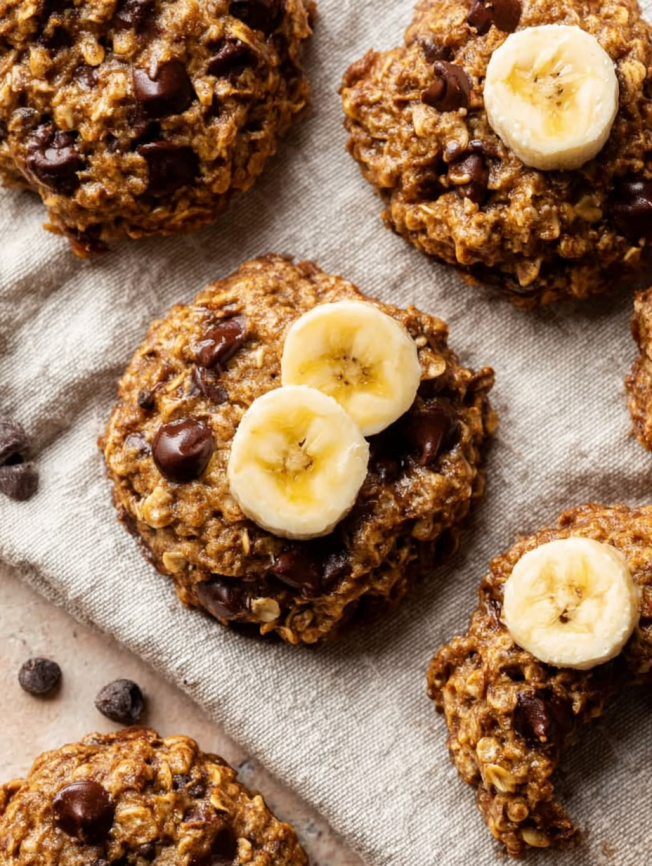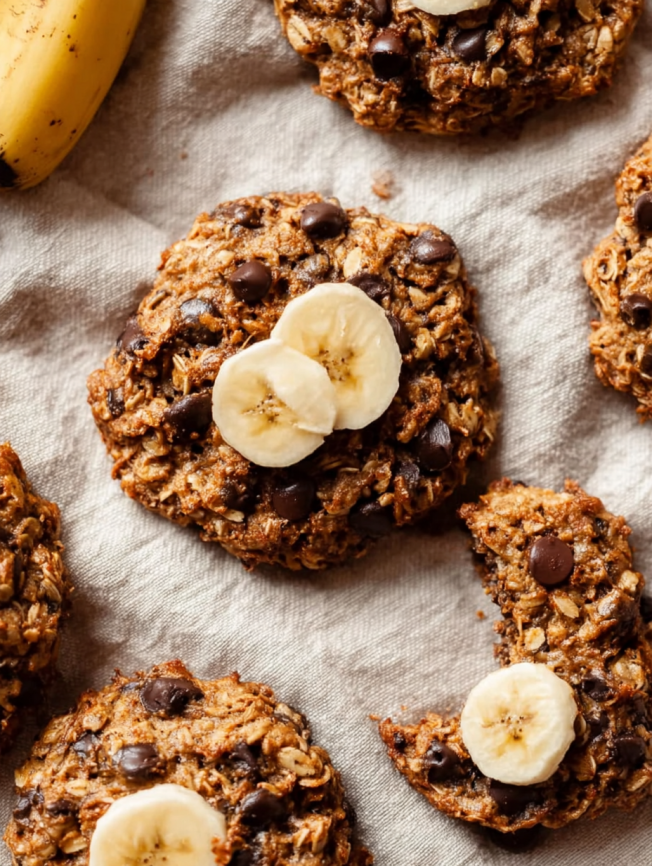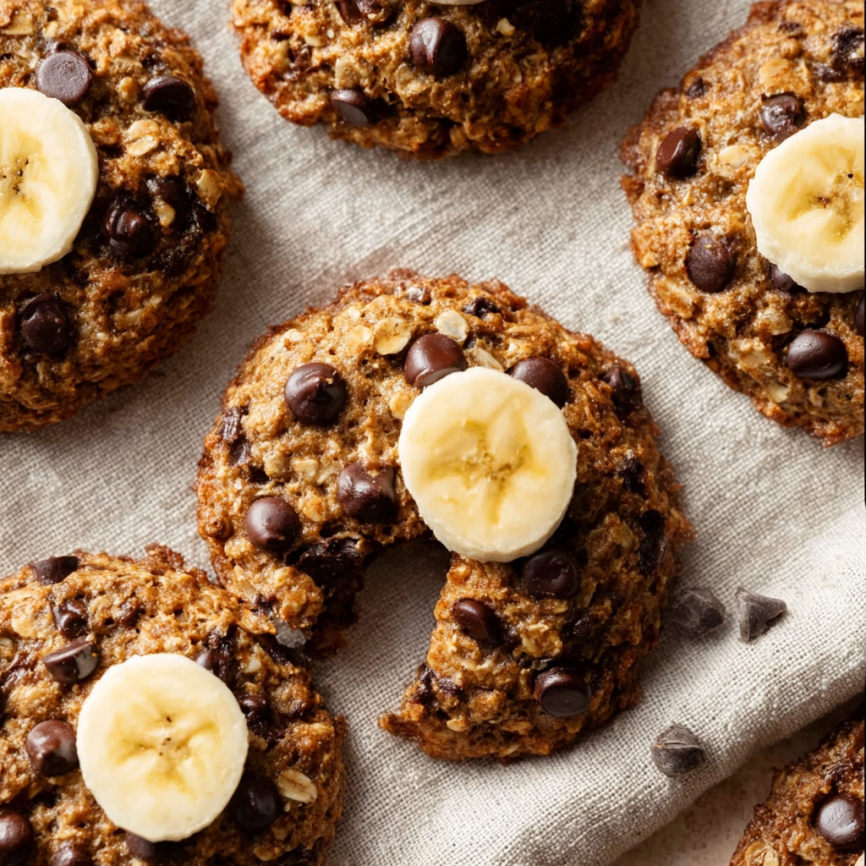Prep Time: 10 minutes | Cook Time: 17 minutes | Total Time: 45 minutes | Yield: 12 cookies
Description: These banana chocolate chip breakfast cookies are made with wholesome, healthy ingredients. Use certified gluten-free oats to make them gluten free, and/or use dairy-free chocolate chips to make them vegan.
When Morning Treats Meet Nutritional Goals
There’s something wonderfully rebellious about eating cookies for breakfast, yet these particular treats make that indulgence feel completely justified. Born from my desire to create something that satisfied both my sweet tooth and my nutritional conscience, these cookies represent the perfect marriage of comfort food satisfaction and wholesome ingredients.
The inspiration struck during one of those hectic mornings when I desperately needed something portable, satisfying, and nutritious to fuel my day. Traditional breakfast options felt too time-consuming, while typical grab-and-go items left me feeling sluggish by mid-morning. After experimenting with countless combinations of healthy ingredients, these cookies emerged as the perfect solution—they taste like an indulgent treat while providing sustained energy through natural, unprocessed ingredients.
What makes these cookies truly special is how they transform ordinary pantry staples into something that feels both virtuous and indulgent. Each bite delivers the comforting sweetness of ripe bananas, the satisfying richness of almond butter, and those delightful bursts of chocolate that make any morning feel like a celebration.
Why These Cookies Will Transform Your Morning Routine
These aren’t your typical breakfast cookies that masquerade as healthy while still being loaded with refined sugar and processed ingredients. Instead, they derive their sweetness primarily from naturally ripe bananas and pure maple syrup, creating complex flavors that develop beautifully as the cookies bake.
The texture strikes an ideal balance between chewy and tender, thanks to the combination of oats for heartiness, almond butter for richness, and coconut oil for the perfect amount of moisture. Unlike many healthy baked goods that can feel dense or virtuous in an unpleasant way, these cookies maintain that satisfying cookie experience while delivering genuine nutritional benefits.
Perhaps most importantly, these cookies actually improve your morning rather than derailing it. The combination of complex carbohydrates from oats, healthy fats from almond butter and coconut oil, and natural sugars from bananas provides steady energy release that keeps you satisfied for hours. Meanwhile, the fiber content helps regulate blood sugar, preventing those mid-morning energy crashes that plague so many breakfast choices.
The versatility factor makes these cookies even more appealing. They work beautifully for various dietary needs—easily adapted to be gluten-free, vegan, or nut-free depending on your substitutions. This adaptability means everyone in your household can enjoy the same delicious breakfast treat regardless of their dietary restrictions.
Essential Ingredients and Their Nutritional Roles
The Natural Sweetness Foundation
- 1 cup (230g) mashed bananas (about 3 medium or 2 large ripe bananas)
- 1/4 cup (82g) pure maple syrup (or honey)
The Hearty Base Components
- 2½ cups (213g) quick oats or old-fashioned whole rolled oats
- 1/2 teaspoon salt
- 1/2 teaspoon ground cinnamon
The Binding and Richness Elements
- 1/4 cup (56g) coconut oil, melted
- 3/4 cup (185g) natural-style almond butter
- 1/2 cup (80g) dairy-free chocolate chips (or regular semi-sweet)
Each ingredient serves multiple purposes beyond just flavor. Bananas provide natural sweetness, moisture, and potassium, while oats contribute fiber, protein, and complex carbohydrates that provide sustained energy. Almond butter delivers healthy fats, protein, and vitamin E, while coconut oil adds beneficial medium-chain fatty acids and helps create the perfect texture.
Step-by-Step Instructions for Perfect Results
Preparing Your Baking Setup
Begin by preheating your oven to 325°F (163°C), which is slightly lower than typical cookie temperatures. This gentler heat allows the cookies to bake evenly throughout without burning the natural sugars. Line two large baking sheets with parchment paper or silicone baking mats—this prevents sticking and ensures easy cleanup.
Creating the Perfect Cookie Dough
Start by mashing your bananas in a large bowl until they reach a relatively smooth consistency with just a few small lumps remaining. These small pieces add pleasant texture to the finished cookies while ensuring even distribution throughout the dough.
Add all remaining ingredients to the bowl with the mashed bananas, stirring everything together until completely combined. The dough will be thick and somewhat heavy—this is exactly what we want for cookies that hold their shape and provide satisfying substance. You can mix by hand with a sturdy wooden spoon, or use a handheld or stand mixer with a paddle attachment if you prefer.
Shaping and Baking Techniques
Using a 1/4 cup measuring cup, scoop generous mounds of dough onto your prepared baking sheets. Each cookie should weigh approximately 70 grams, creating substantial breakfast portions that will keep you satisfied. Space the mounds about 2 inches apart, as these cookies maintain their shape during baking rather than spreading significantly.
Use the back of a spoon to gently flatten each mound into a cookie shape—don’t worry about making them perfectly uniform, as the slightly rustic appearance adds to their homemade charm. The flattening step ensures even baking and creates the ideal thickness for the perfect chewy-tender texture.
Achieving the Perfect Bake
Bake for 17-20 minutes, checking for lightly browned edges as your doneness indicator. The centers should still appear slightly soft when you remove them from the oven—they’ll continue cooking from residual heat and firm up as they cool.
Allow cookies to cool on the baking sheets for 10 minutes before transferring to a wire rack. This initial cooling period prevents breaking while the cookies are still fragile from the heat, ensuring they maintain their shape during the transfer process.
Texture and Flavor Development
Understanding the Cooling Process
These cookies undergo interesting textural changes as they cool and age. Fresh from the oven, they have a tender, almost cake-like quality that many people find irresistible. However, as they cool completely and especially after storage, they develop a more traditional cookie texture with pleasant chewiness.
Interestingly, these cookies often taste even better after a day of storage. The flavors meld together beautifully, creating more complex taste profiles as the ingredients have time to integrate. Many people prefer them straight from the refrigerator, where they develop a delightfully dense, almost fudge-like quality.
Flavor Enhancement Tips
For deeper flavor complexity, consider toasting your oats in a dry skillet for 3-4 minutes before incorporating them into the dough. This simple step adds nutty undertones that complement the banana and almond butter beautifully.
Similarly, using very ripe bananas with brown spots creates more intense banana flavor and natural sweetness. Don’t shy away from bananas that might seem too ripe for eating—they’re perfect for these cookies and contribute to the overall richness of flavor.

Creative Customization Options
Mix-In Variations
While chocolate chips provide classic appeal, numerous other additions can transform these cookies for different preferences and occasions. Try dried fruit like cranberries, raisins, or chopped dates for chewy sweetness, or add chopped nuts like walnuts or pecans for additional protein and crunch.
For tropical variations, consider shredded coconut and dried pineapple pieces. Autumn flavors come alive with the addition of pumpkin pie spice (instead of just cinnamon) and dried cranberries, while winter holidays call for white chocolate chips and dried cherries.
Dietary Adaptations
Transform these cookies for various dietary needs with simple substitutions. For nut-free versions, replace almond butter with sunflower seed butter, which provides similar richness and binding properties. Ensure your chocolate chips are also nut-free if this is a concern.
Gluten-free adaptations require only certified gluten-free oats, as all other ingredients are naturally gluten-free. For vegan versions, use dairy-free chocolate chips and maple syrup instead of honey if you were considering that substitution.
Spice and Flavor Variations
Experiment with different spice combinations to create unique flavor profiles. Try adding 1/4 teaspoon each of nutmeg and vanilla extract for classic warmth, or incorporate 1/2 teaspoon of cardamom for Middle Eastern-inspired flavors.
For chocolate lovers, add 2 tablespoons of cocoa powder to create double chocolate versions, adjusting the liquid ingredients slightly if the dough becomes too thick.
Storage and Make-Ahead Strategies
Optimal Storage Methods
Store completely cooled cookies in an airtight container at room temperature for up to 2 days, though they’re often preferred after refrigerator storage. In the refrigerator, they’ll maintain quality for up to 10 days and develop that beloved dense, chewy texture many people prefer.
For individual portions, wrap cookies in parchment paper or plastic wrap—this makes them perfect for grab-and-go breakfasts or packed lunches. The wrapped cookies can be stored in larger containers or bags for organization.
Freezing for Long-Term Storage
These cookies freeze exceptionally well for up to 3 months. Layer them between parchment paper sheets in freezer-safe containers to prevent sticking and freezer burn. Label containers with the date and any variations you’ve made for easy identification.
Frozen cookies can be enjoyed directly from the freezer for a cold treat, or thawed at room temperature for 15-20 minutes. For warm cookies, microwave frozen ones for 10-15 seconds, watching carefully to prevent overheating.
Troubleshooting Common Issues
Texture Problems
If your cookies turn out too dense or heavy, the likely culprit is the almond butter type. Processed, thick almond butters create overly dense results—always use natural, drippy varieties that pour easily from the jar. Additionally, ensure you’re not overpacking your measuring cups, which can throw off ingredient ratios.
Cookies that spread too much during baking usually indicate overripe, overly wet bananas or insufficient oat content. Drain excess liquid from very ripe bananas before mashing, and consider adding an extra 1/4 cup of oats if your dough seems too wet.
Binding Issues
Cookies that fall apart or crumble typically need more binding ingredients. Ensure your coconut oil is properly melted and incorporated, and verify that you’re using enough mashed banana. Sometimes adding an extra tablespoon of almond butter can improve cohesion.
If cookies seem dry or don’t hold together well, your bananas might not have been ripe enough, or you may need to add a tablespoon of additional liquid (maple syrup or melted coconut oil work well).
Nutritional Benefits and Considerations
Energy and Satiation
These cookies provide sustained energy through their combination of complex carbohydrates, healthy fats, and natural proteins. The fiber from oats helps regulate blood sugar, preventing energy crashes that often follow traditional breakfast sweets.
Each cookie delivers approximately 200-250 calories with a good balance of macronutrients, making them substantial enough to serve as a complete breakfast when paired with coffee or tea. The protein content from almond butter helps maintain satiation throughout the morning.
Micronutrient Content
Bananas contribute potassium for heart health and proper muscle function, while almond butter provides vitamin E, magnesium, and healthy monounsaturated fats. Oats add B vitamins and additional minerals, creating a nutritionally dense breakfast option that surpasses many traditional choices.
The natural sweeteners provide trace minerals often absent in refined sugars, while the minimal processing of ingredients means maximum retention of beneficial compounds.
Professional Baking Tips
Ingredient Quality Matters
Invest in high-quality, natural almond butter for the best results. The oil separation in natural nut butters is actually beneficial for these cookies, providing the right consistency and flavor. Stir the jar thoroughly before measuring to ensure even distribution of oils and solids.
Choose oats based on your texture preferences—quick oats create more uniform, tender cookies, while old-fashioned oats provide more textural interest and chewiness. Both work excellently, so the choice depends on your personal preference.
Temperature and Timing
The lower baking temperature (325°F) is crucial for even cooking without burning the natural sugars present in bananas and maple syrup. Don’t be tempted to increase the temperature for faster baking—this often results in overbrowned exteriors and undercooked centers.
Watch for visual cues rather than relying solely on timing, as ovens vary significantly. The edges should be lightly golden, and the centers should appear set but still slightly soft when you remove the cookies from the oven.

Frequently Asked Questions
Can I use bananas that aren’t very ripe? Very ripe bananas with brown spots work best because they’re sweeter and easier to mash. Underripe bananas lack sufficient natural sweetness and can create a more starchy flavor. If your bananas aren’t quite ripe enough, add an extra tablespoon of maple syrup to compensate.
What if I don’t have almond butter? Natural peanut butter, cashew butter, or sunflower seed butter all work as direct substitutions. Each will create slightly different flavors while maintaining the same basic texture and nutritional profile. Avoid processed nut butters as they can make the cookies too dense.
Why don’t my cookies hold together well? This usually indicates insufficient binding ingredients or bananas that weren’t ripe enough. Ensure you’re using properly ripe, sweet bananas and that your coconut oil is fully melted and incorporated. Sometimes adding an extra mashed banana half can solve binding issues.
Can I make the dough ahead of time? Yes, cookie dough can be prepared and refrigerated for up to 24 hours before baking. The dough may thicken slightly in the refrigerator, which actually makes it easier to handle and shape. Allow it to come to room temperature for 10-15 minutes before scooping if it becomes too firm.
How do I know when the cookies are done? Look for lightly browned edges and centers that appear set but still slightly soft. The cookies will continue cooking from residual heat after removal from the oven. Overbaking creates dry, crumbly cookies, so err on the side of underbaking slightly.
Can I reduce the sweetness? Absolutely! Start by reducing the maple syrup to 2-3 tablespoons, though very ripe bananas provide considerable natural sweetness. You can also try using unsweetened chocolate chips or reducing the chocolate chip quantity slightly.
Do these cookies work for meal prep? These cookies are excellent for meal prep! Bake a batch on Sunday and store them in the refrigerator for quick breakfasts throughout the week. They actually improve in flavor after a day or two of storage.
Can I make smaller or larger cookies? Yes, adjust the baking time accordingly. Smaller cookies (using a 2-tablespoon scoop) will need about 12-15 minutes, while larger cookies might need 22-25 minutes. The 1/4-cup size provides the ideal balance of cooking time and portion size for breakfast.

